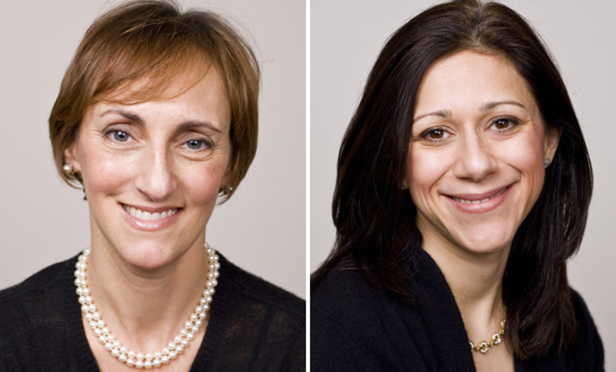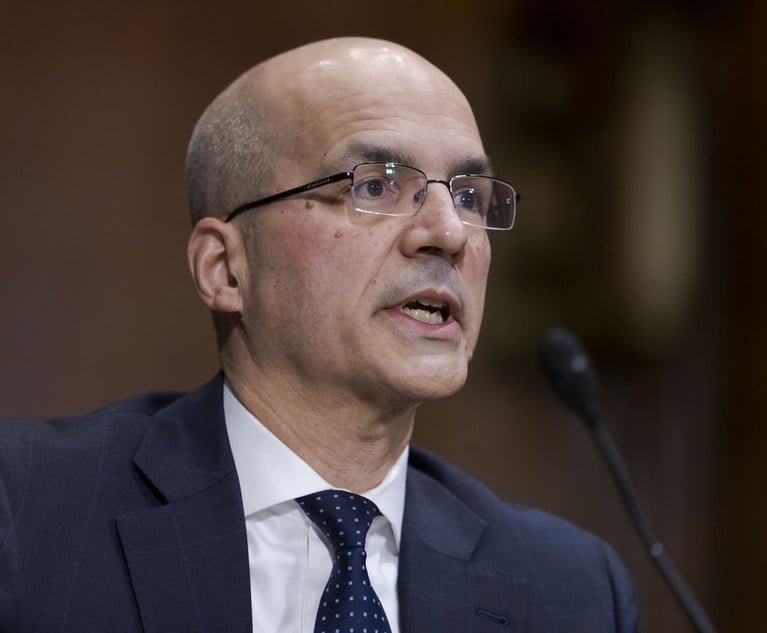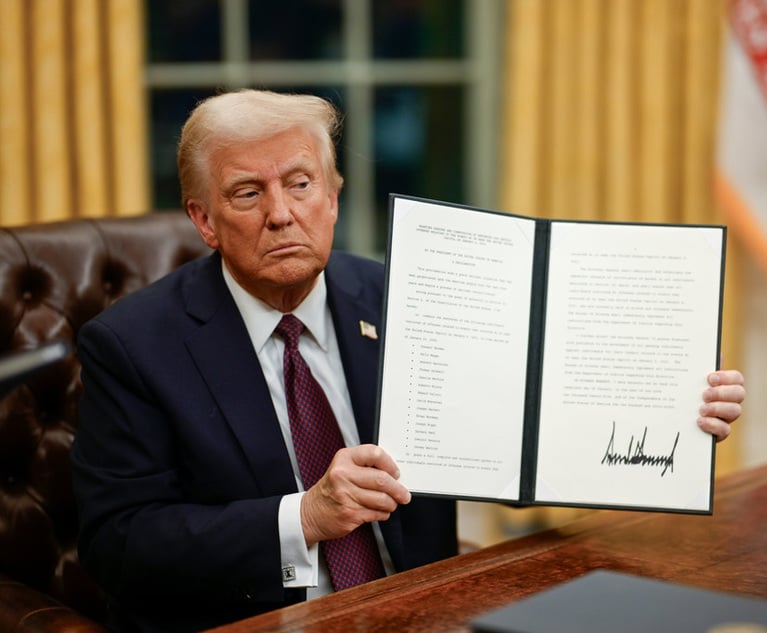Addressing Human Rights Violations With Mediation
Mediation columnists Abby Tolchinsky and Ellie Wertheim write: The international human rights community is contemplating a role for mediation in redressing a subset of human rights violations.
December 11, 2018 at 02:45 PM
8 minute read
 Abby Tolchinsky and Ellie Wertheim
Abby Tolchinsky and Ellie Wertheim
News outlets across the globe are rife with accounts of human rights violations. In some instances, these violations are attached to non-state actors (whether individuals or organized groups) who, in some manner, abuse or deny individuals their basic human rights, as set out within the UN's Universal Declaration of Human Rights and/or various U.S. statutes and the Constitution. Generally speaking, the definition of human rights as set out in the Universal Declaration includes, but is not limited to: the right to asylum; freedom from interference with family and home; and freedom from torture. Furthermore, both the Universal Declaration and the U.S. Constitution enumerate the right to equality; life; freedom of religion; and freedom from discrimination.
Recent cases of non-state actor human rights abuses include the 2018 anti-Semitic Pittsburgh synagogue shooting, and sexual harassment brought to light by the #MeToo movement. Though the Pittsburgh synagogue shooter allegedly acted alone, his actions are thought to have stemmed from the white supremacist and white terrorism movement within the United States. Likewise, the #MeToo movement connected reports of individual cases of workplace sexual harassment and assault to larger societal concerns surrounding the violation of women's human rights—including the right to be free from sexual harm as set out within the UN Declaration on the Elimination of Violence Against Women. More commonly, instances of non-state actor human rights violations within the United States take the form of housing rights, workers' rights, and public assembly rights violations, all of which are encompassed within Articles 16-30 of the Declaration of Human Rights. For example, New York City community groups, collectively titled the Broadway Triangle Community Coalition, brought a suit claiming racial discrimination against a Brooklyn housing development project situated on city land. After eight years of litigation, the plaintiffs prevailed in a 2017 settlement agreement that protected housing rights, and provided additional affordable housing units in compliance with Article 25(1) of the Universal Declaration of Human Rights.
Examples of non-state actor human rights violations are not, of course, confined solely to the United States and comparative incidents and remedies are instructive. Across the border in Canada, a class action lawsuit alleging the forced sterilization of Indigenous women by medical professionals, as recently as 2017, reveals Canada's history of violating the Convention on the Prevention and Punishment of Genocide. While current cases of forced sterilization are just now being explored, when addressing past instances of human rights violations, Canada has utilized restorative justice processes. For instance, after evidence revealed the cultural genocide intent behind the former Canadian Residential School Program—a mandatory Indigenous school program aimed at assimilating Indigenous children into mainstream society through ethnic cleansing—a restorative justice tool referred to as a Truth and Reconciliation Commission (TRC) was administered. Generally speaking, TRCs are designed to promote reconciliation by acknowledging and apologizing for injustices, and by promoting truth-seeking. They are also meant to empower and promote healing amongst survivors. To this end, many participants of the Canadian TRC reported that the process satisfied their need for acknowledgment, and in many ways initiated the healing process. At the same time, for many Indigenous people the TRC of Canada is seen as a start, with more being required to truly rectify the situation. The Canadian Human Rights Commission has included a mediation provision within their Dispute Operating Procedures, and mediation has been used in an attempt to remedy human rights violations.
Additionally, human rights violations arise directly from the actions of state-actors. Recently, in the United States, the Trump administration has been the subject of criticism by international and local human rights organizations as well as citizens' protests resulting from: executive order 13769 suspending the United States' refugee program and enforcing the “Muslim ban”; separating families at the border and within detention centers; allowing over 10,000 unaccompanied minors to reside in tent cities. Beyond immigration rights, the Trump administration has faced similar criticism following the overturn of policies relating to sexual violence on university campuses, and pay equity initiatives, among others.
Victims of human rights violations within the United States face many potential barriers in their pursuit of full and satisfactory redress. While anyone can bring a human rights complaint before the United Nations, the resulting decisions are not legally binding and risk opening complainants up to further victimization. At the same time, while domestically Sosa v. Alvarez-Machain, 542 U.S. 692 (2004) secured Americans and foreign nationals the right to sue in federal or state court for human rights infractions, the cost and the lengthy nature of these cases—taking, in many instances, eight to 10 years—deter many plaintiffs from filing. For those who move forward with litigation, finding a suitable attorney can be difficult since outcomes are hard to predict given the high evidentiary burden that plaintiffs must satisfy in order to prevail, not to mention the cost of litigation. As a result, many victims rely on human rights services external to the court systems such as the New York City Commission on Human Rights, the New York State Division of Human Rights, or more generally, the U.S. Equal Employment Opportunity Commission and the U.S. Department of Housing and Urban Development. These adjudicative bodies present many of the same challenges found within the court system—extensive wait times, high caseloads, expenses and needed expertise, particularly for pro se litigants.
Although adjudication within the courts or a recognized human rights commission remains the preferred avenue for these claims, both within the United States and beyond, the international human rights community is contemplating a role for mediation in redressing a subset of human rights violations. In particular, in states with heavy docket loads and high case filing rates, mediation could fill an as yet unaddressed gap, as we have seen in Canada. As the availability of mediation attracts individuals looking for a more personal and potentially efficient process, the burden on the courts and human rights enforcement agencies will necessarily be reduced. For the parties themselves, mediation may offer an opportunity to settle meaningfully while retaining the right to pursue litigation, should the mediation prove unsuccessful.
ADR encompasses non-litigation avenues ranging from the restorative justice process to mediation. And, while a variety of ADR techniques may prove useful in human rights cases, mediation in particular provides a platform where claimants, with the assistance of a neutral third-party mediator, can present their cases either directly to the alleged perpetrator, or indirectly to a representative such as a senior member of the organization responsible for the harm. For the majority of human rights abuse cases, there is a strong likelihood that an added mediation component could benefit not only the parties involved, but also the human rights enforcement and violation review system as a whole.
More important however, mediation provides a platform whereby parties have the opportunity to fully discuss all relevant components of the conflict from both sides, a process which can be healing to participants in a manner that a typical court proceeding does not provide. While taking into account the victims' experiences, values, and needs, participants are encouraged to devise creative solutions that move beyond monetary awards issued by the majority of courts and tribunals. Examples of creative solutions that may arise from mediation include: policy amendments; agreements to attend training and/or counselling; educational media campaigns, among others. For many plaintiffs, these non-monetary awards help facilitate further healing, and provide them with a sense of justice and acknowledgement. Likewise, for defendants, the mediation process can reduce the recurrence of future violations, while also maintaining the public stature of government entities, corporations, or non-state actors. At the same time, the voluntary nature of human rights mediations implies buy-in from all parties; meaning, the likelihood of compliance may be higher for agreements reached via voluntary mediation than for judgments imposed by the courts without party input.
It is important to note that mediation is not appropriate in all human rights cases. Critics raise concerns of a risk of victims re-living their trauma or facing their abuser(s) during the mediation process. Given the severity and deep emotional underpinnings surrounding some human rights cases, such concerns may be warranted and must be assessed by the mediator and the parties on a case-by-case basis. However, in appropriate cases mediation may well be a productive process for ensuring that human rights violations are adequately and efficiently addressed.
Abby Tolchinsky and Ellie Wertheim are partners at Family Mediation. Makenzie Way, a J.D. candidate at the University of Pennsylvania Law School, assisted in the preparation of this column.
This content has been archived. It is available through our partners, LexisNexis® and Bloomberg Law.
To view this content, please continue to their sites.
Not a Lexis Subscriber?
Subscribe Now
Not a Bloomberg Law Subscriber?
Subscribe Now
NOT FOR REPRINT
© 2025 ALM Global, LLC, All Rights Reserved. Request academic re-use from www.copyright.com. All other uses, submit a request to [email protected]. For more information visit Asset & Logo Licensing.
You Might Like
View All
'Serious Legal Errors'?: Rival League May Appeal Following Dismissal of Soccer Antitrust Case
6 minute read
How Some Elite Law Firms Are Growing Equity Partner Ranks Faster Than Others
4 minute read
Trending Stories
- 1Rejuvenation of a Sharp Employer Non-Compete Tool: Delaware Supreme Court Reinvigorates the Employee Choice Doctrine
- 2Mastering Litigation in New York’s Commercial Division Part V, Leave It to the Experts: Expert Discovery in the New York Commercial Division
- 3GOP-Led SEC Tightens Control Over Enforcement Investigations, Lawyers Say
- 4Transgender Care Fight Targets More Adults as Georgia, Other States Weigh Laws
- 5Roundup Special Master's Report Recommends Lead Counsel Get $0 in Common Benefit Fees
Who Got The Work
J. Brugh Lower of Gibbons has entered an appearance for industrial equipment supplier Devco Corporation in a pending trademark infringement lawsuit. The suit, accusing the defendant of selling knock-off Graco products, was filed Dec. 18 in New Jersey District Court by Rivkin Radler on behalf of Graco Inc. and Graco Minnesota. The case, assigned to U.S. District Judge Zahid N. Quraishi, is 3:24-cv-11294, Graco Inc. et al v. Devco Corporation.
Who Got The Work
Rebecca Maller-Stein and Kent A. Yalowitz of Arnold & Porter Kaye Scholer have entered their appearances for Hanaco Venture Capital and its executives, Lior Prosor and David Frankel, in a pending securities lawsuit. The action, filed on Dec. 24 in New York Southern District Court by Zell, Aron & Co. on behalf of Goldeneye Advisors, accuses the defendants of negligently and fraudulently managing the plaintiff's $1 million investment. The case, assigned to U.S. District Judge Vernon S. Broderick, is 1:24-cv-09918, Goldeneye Advisors, LLC v. Hanaco Venture Capital, Ltd. et al.
Who Got The Work
Attorneys from A&O Shearman has stepped in as defense counsel for Toronto-Dominion Bank and other defendants in a pending securities class action. The suit, filed Dec. 11 in New York Southern District Court by Bleichmar Fonti & Auld, accuses the defendants of concealing the bank's 'pervasive' deficiencies in regards to its compliance with the Bank Secrecy Act and the quality of its anti-money laundering controls. The case, assigned to U.S. District Judge Arun Subramanian, is 1:24-cv-09445, Gonzalez v. The Toronto-Dominion Bank et al.
Who Got The Work
Crown Castle International, a Pennsylvania company providing shared communications infrastructure, has turned to Luke D. Wolf of Gordon Rees Scully Mansukhani to fend off a pending breach-of-contract lawsuit. The court action, filed Nov. 25 in Michigan Eastern District Court by Hooper Hathaway PC on behalf of The Town Residences LLC, accuses Crown Castle of failing to transfer approximately $30,000 in utility payments from T-Mobile in breach of a roof-top lease and assignment agreement. The case, assigned to U.S. District Judge Susan K. Declercq, is 2:24-cv-13131, The Town Residences LLC v. T-Mobile US, Inc. et al.
Who Got The Work
Wilfred P. Coronato and Daniel M. Schwartz of McCarter & English have stepped in as defense counsel to Electrolux Home Products Inc. in a pending product liability lawsuit. The court action, filed Nov. 26 in New York Eastern District Court by Poulos Lopiccolo PC and Nagel Rice LLP on behalf of David Stern, alleges that the defendant's refrigerators’ drawers and shelving repeatedly break and fall apart within months after purchase. The case, assigned to U.S. District Judge Joan M. Azrack, is 2:24-cv-08204, Stern v. Electrolux Home Products, Inc.
Featured Firms
Law Offices of Gary Martin Hays & Associates, P.C.
(470) 294-1674
Law Offices of Mark E. Salomone
(857) 444-6468
Smith & Hassler
(713) 739-1250







